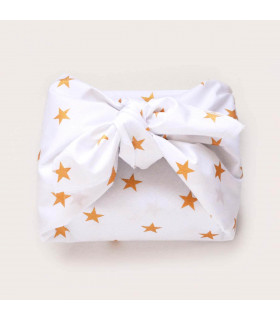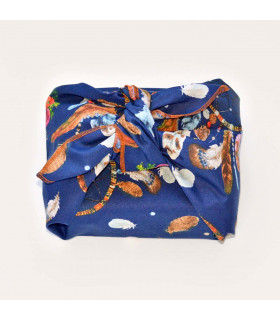As the end of the year celebrations approach, the gifts multiply under the tree to please their loved ones. Very often, they are covered with gift wrap so that nothing shows through and keep the surprise until the end. But wrapping paper is a real scourge. Very quickly ripped, torn and put aside, its life use in the house is only a few seconds while outside it is much longer. Its ecological impact is therefore no longer to be proven. Every year, tons of packaging are thrown away and only a tiny fraction is recycled. However, there is a zero waste alternative that has revolutionized the different ways of wrapping a gift. This is furoshiki, a folding technique originating in Japan that has nothing to envy to classic supermarket wrapping paper. The technique seems slightly complicated, but you just have to learn and familiarize yourself with this new process, and you will find that it is ultimately very easy to do. You will no longer need to buy several rolls of gift wrapping paper which will considerably increase your waste. A square of plain and colored fabric or printed patterns and a helping hand to get used to it and voila !
What's a furoshiki?
Called "fabric origami", furoshiki is an ancient folding and knotting technique that came directly from Japan. The fabric was then used as a container for the Japanese to put their clothes and other personal belongings on before going to the public baths. The furoshiki was then decorated with motifs or the family crest to prevent their goods from being exchanged by mistake. Very quickly, it became popular and became an essential element for transporting everyday objects such as groceries or meals for the lunch break or more recently to wrap gifts as a star alternative to zero waste.
Very often decorated with traditional patterns, it is not only ideal for making pretty wrapping paper, but it also has real meaning in Japan. Choosing a furoshiki is not trivial and depending on the chosen patterns, it sends a message to the person who receives it. So, on every occasion, whether it is a happy event (birth, marriage) or an unhappy event (illness, death), the colors and prints selected have a special meaning. The cherry leaf, for example, is used on a furoshiki to herald spring and the maple leaf to herald fall. Some bright colors like purple represent a symbol of longevity while darker hues are generally associated with less happy, more subdued events. There is a furoshiki for every occasion to celebrate. And you won't run out of it! There are different sizes and types of furoshiki to meet your different needs. If its shape is traditionally rectangular, today it has given way to the square shape and now adapts to the use you want to make of it. Whether it is a box, a bottle, one or more books or even to transport dishes or clothes, the size and type of furoshiki selected depends on the item you have in your bag. possession and how you want to pack it. Its fabric is often thick to avoid being able to see through it.
Between tradition and modernity, furoshiki is more than a piece of fabric to make bundles. Its history does not date from yesterday but it is more current than ever in the face of environmental issues and the zero waste movement. The emergence of the plastic bag has strongly put it aside, but it reappears and reinvents itself thanks to artists who have fun creating new patterns and colors to highlight it.
How to use and fold a furoshiki?
Furoshiki is endlessly reusable and easy to use, once you get the hang of it. First, don't forget to check that your fabric is square in shape. Symmetry is essential to achieve successful furoshiki packaging. The fabric should neither be too soft for the wrapper to hold up over time, nor too thick that it will fail to tie it. The material of the fabric varies, it can be cotton, silk or more synthetic material but the choice is up to you and your ecological sensitivity. The furoshiki is already a first step, but if you want to go further, for example prefer organic cotton materials. Its size is generally between 45 and 240 cm per side. The ideal is to make sure that there is enough space on each side, but also to choose a fabric that is as beautiful on the right side as on the back, because when you have folded it, it will be visible on both sides.
Then choose the one you like, its printed patterns, its color, have fun while making sure to keep a thick fabric to hide and wrap your gift. The advantage of furoshiki is that it is often second-hand and therefore environmentally friendly. You can of course buy fabric, but think above all about your old clothes that are too worn out to be worn or even your pillowcases, sheets and even tea towels that could easily be reused for this purpose. Once you have your different fabric scraps (which will make great furoshiki) available, you can now tackle the folding techniques. Mastery of knots is essential to have a good base and learn the different bends.
Indeed, the furoshiki technique is not only used for objects and gifts but can also be used to make a bundle, a handbag, a tote or even a backpack (with or without a shoulder strap). It can also be used as a book holder or bottle holder, so it is not limited to one use only. It is also perfect for transporting food shopping as long as you select a fabric that is resistant enough not to drop everything. The best known and used technique (and the easiest to perform) is the two knot technique. It doesn't require a lot of training and can be learned in no time. How to achieve it? It is very simple ! Just place your object in the center of the fabric. Then take the two opposite sides diagonally to make a first knot and tie a second knot by turning the object. If you have a creative mind, ready to take on any challenge, there is more to furoshiki than just one folding technique. There are a multitude of them to know to make unique packaging that will enhance your Christmas decorations and the base of your tree. Everything will depend once again on the gift inside, its shape and size which are parameters to take into account to make the prettiest gift package.
What are the advantages of furoshiki ?
Using a furoshiki for wrapping also means giving a second gift to your loved ones. They might be surprised at first glance, but you can explain to them that this is a zero waste wrapping and knotting technique and that the fabric, unlike the gift pack, may be kept, reused and passed on to another household. A great initiative to introduce those who are still reluctant to trade their habits for a simple cloth. No more packaging that pollutes the home, takes up too much space and is thrown away as soon as it is used. The art of furoshiki is the perfect alternative to single-use plastic bags. From a single square of fabric, it is possible to make original gift packaging that will enhance your homes for parties, birthdays and all other special occasions. An infinity of combinations where everything is simply in the way of tying! You just have to let your creativity express itself to make unique and ecological shopping bags, practical and simple packaging to continue to reduce your waste while learning through the new furoshiki technique. ways to change your daily life and consumption. A great way to bring other zero waste gestures during these holiday periods and to take care of your environment, but also and always to surprise your loved ones and get them too to adopt furoshiki. You will not be able to do without it!
Latest tips you might not have thought of. It can also be recycled in an unexpected but much appreciated way. If you simply have too many fabrics in storage (either by yourself or given out as gifts given out), you may also consider doing a bit of sewing, if you know your way around. You may not have thought about it, but since it is a fabric, you can easily reuse it as a scarf, sarong during your beach trips in summer or even make sheets. Zero waste is not only in reducing waste but also in the ability to reuse items around you.



















